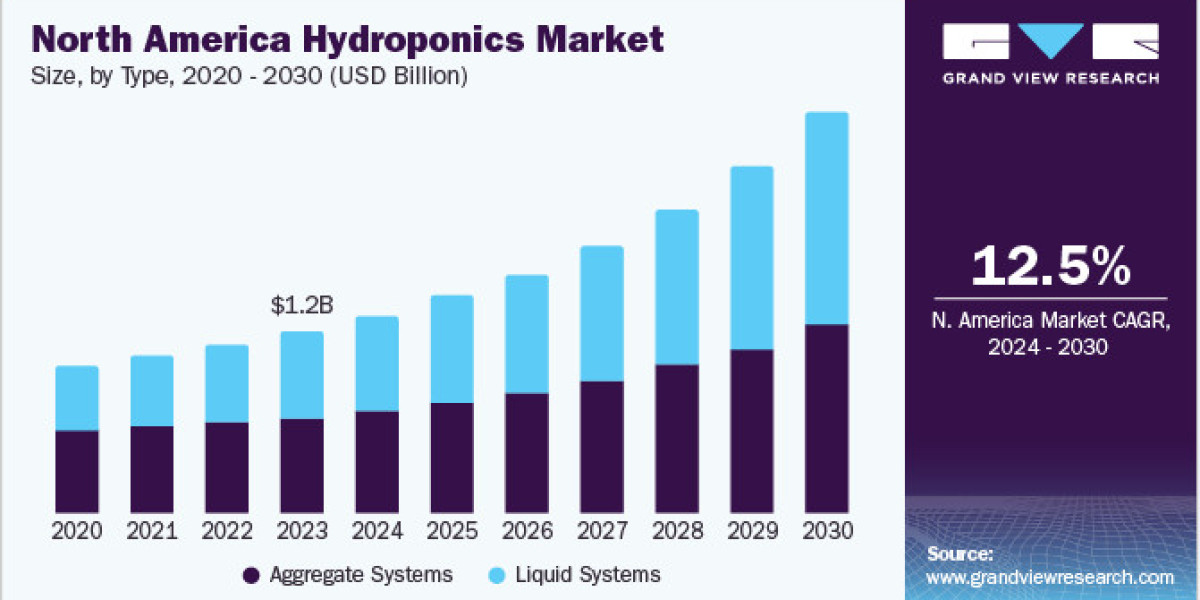The global hydroponics market was valued at USD 5.00 billion in 2023 and is projected to expand at a compound annual growth rate (CAGR) of 12.4% from 2024 to 2030. The sector’s rapid growth is largely driven by the increasing use of hydroponic systems for indoor vegetable cultivation. A key contributor to this trend is the rising acceptance of alternative farming methods, especially for cannabis cultivation, following the legalization of marijuana in various countries like Canada, the Czech Republic, and South Africa. Additionally, growing consumer awareness about the harmful health effects of pesticides and artificial ripening agents is expected to further boost demand for hydroponics, as this method does not require these substances, resulting in healthier vegetables. The low installation costs and operational ease of hydroponics systems are also projected to encourage their widespread adoption during the forecast period.
Hydroponic farming is a soil-free technique that uses a mineral solution placed around plant roots. In this method, roots are immersed in a nutrient solution that is carefully monitored to ensure the right chemical balance for growth. This approach reduces the risk of diseases associated with soil-based cultivation, while precise nutrient control allows hydroponic crops to yield more than those grown in soil.
Gather more insights about the market drivers, restrains and growth of the Global Hydroponics Market
The growing global population is amplifying food demand. According to the Food and Agriculture Organization (FAO) of the United Nations, the world population could reach 9.1 billion by 2050, necessitating a 25-70% increase in food production. This increase is expected to drive the demand for alternative, high-yield farming technologies capable of quick production cycles. In regions like the Asia Pacific and Europe, where arable land and water resources are limited, the adoption of efficient, high-yield technologies is on the rise, supporting the growth of the hydroponics market.
Advancements in climate control, nutrient management, and sensor technology are anticipated to positively impact market growth during the forecast period. Hydroponic farming providers offer various tools for monitoring crops, including sensors, web-based platforms, software, and mobile applications. For example, SmartBee Technology, Inc., provides farmers with real-time control solutions, such as irrigation, water and nutrient sensors, and environmental monitoring software.
The hydroponics market is primed for growth due to several factors, including a rising global population, limited arable land, government support, and increased demand for fresh, high-quality produce. Approximately 80% of the world’s population resides in urban areas, according to the World Health Organization (WHO) and the Population Council. Urban land scarcity has led to innovative cultivation methods like hydroponics, enabling growers to maximize space by growing indoors with vertical systems, in multi-story buildings, or in warehouses.
Hydroponic systems use nutrient-rich water instead of soil for growing plants. Combining various technologies, these systems allow growers to achieve higher yields per harvest while reducing the need for pesticides and herbicides compared to traditional methods. Crops like exotic vegetables, cabbage, peas, and salad greens thrive in hydroponic setups. The availability of online educational resources and discounts has fueled consumer interest in hydroponics, as systems require consistent maintenance and care to cultivate crops like tomatoes, cabbage, and lettuce effectively.
Type Insights
Hydroponics systems are classified into aggregate and liquid systems. Aggregate systems accounted for a 52.5% revenue share in 2023 due to their user-friendly nature. They use inert solid media, such as peat, rock wool, vermiculite, sand, sawdust, perlite, or coconut coir, to support plant growth, with drip, ebb and flow, and wick systems being popular.
The liquid systems segment is expected to achieve the fastest CAGR of 14.2% between 2024 and 2030 due to the rising popularity of closed-system cultivation. Liquid systems, like Deep Water Culture and Nutrient Film Technique (NFT), submerge roots directly in nutrient solutions, simplifying processes and promoting rapid growth and high yields. Although these soilless methods minimize soil-borne diseases, the recirculated nutrient solutions in closed systems could spread pathogens.
Crop Type Insights
The hydroponics market is categorized by crop type, including tomatoes, lettuce, peppers, cucumbers, and herbs. In 2023, tomatoes held the largest revenue share at 44.2% due to their rapid growth rate and reduced water needs compared to traditional farming. Indoor hydroponic tomato farming typically uses substrates like rock wool, perlite, or coconut coir. Substantial growth in tomato cultivation using hydroponics is expected in Europe and Asia Pacific by 2030.
Lettuce is anticipated to see the fastest CAGR of 15.4% from 2024 to 2030, as it is a widely consumed raw vegetable. Hydroponic lettuce farming is expanding in North America, fueled by increasing demand from households and fast-food chains.
Crop Area Insights
Large crop areas, particularly those over 50,000 sq. ft., are expected to contribute significantly to market revenue, as they offer farmers flexibility in cultivating various high-quality crops. Larger spaces allow for multiple hydroponic systems under one roof, improving productivity, operational efficiency, and profitability. Additionally, water conservation benefits make hydroponics an appealing option for large-scale farming operations, enhancing the overall efficiency and scalability of modern agricultural practices.
Order a free sample PDF of the Hydroponics Market Intelligence Study, published by Grand View Research.








